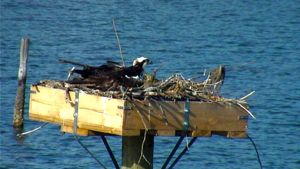About Ospreys
Ospreys (Pandion haliaetus) are of particular interest to researchers at the Virginia Institute of Marine Science because they are the only birds of prey that subsist almost exclusively on a diet of live fish—hence their common name of "fish hawks."
Ospreys are such a common sight above Chesapeake Bay during the spring and summer that it’s easy to forget that our “local” birds spend almost half their year in South America. Indeed, ospreys are one of the most wide-ranging birds in the world. The one constant of their distribution is proximity to water.
Historically, Chesapeake Bay has supported the largest concentration of breeding ospreys in the world.  Breeding pairs repeatedly return to the same nest site, and often remain together for many years. They prefer to build their large stick nests near water at sites with good visibility and limited access for predators.
Breeding pairs repeatedly return to the same nest site, and often remain together for many years. They prefer to build their large stick nests near water at sites with good visibility and limited access for predators.
Osprey populations have increased in the United States since the late 1970s, primarily due to a ban on the widespread use of DDT in 1972. Today, many osprey populations nest almost entirely on artificial nest sites.
Dive deeper to learn more about these amazing birds:

